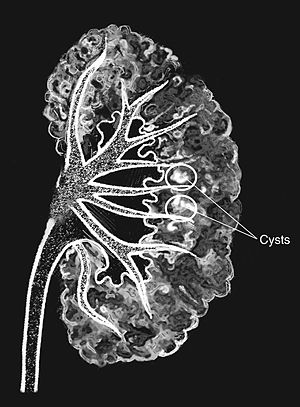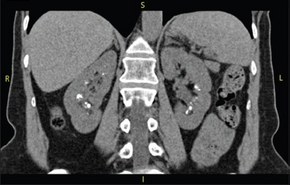Medullary sponge kidney
| Medullary sponge kidney | |
|---|---|
| Other names: Cacchi–Ricci disease, precalyceal canalicular ectasia[1] | |
 | |
| Medullary sponge as seen on an intravenous pyelogram | |
| Specialty | Urology |
| Symptoms | Burning with urination, blood in the urine, flank pain[2] |
| Complications | Urinary tract infections, kidney stones[2] |
| Usual onset | Present at birth[2] |
| Causes | Unclear[2] |
| Diagnostic method | Medical imaging[2] |
| Treatment | Managing UTIs and kidney stones[2] |
| Frequency | 1 in 5,000 people[2] |
Medullary sponge kidney is a birth defect characterized by small cysts in the inner part of the kidneys.[2] Onset of symptoms; however, does not generally occur until late childhood or early adulthood.[2] Symptoms may include those or a urinary tract infection (UTI) such as burning with urination or kidney stone such as flank pain and blood in the urine.[2] Kidney failure is rare.[2]
The cause is unclear.[2] Most cases do not appear to be inherited from a persons parents.[2] The underlying mechanism involves dilation of the collecting ducts and tubules in the renal pyramids.[3] One or both kidneys may be involved.[2] Diagnosis may be supported by medical imaging.[2]
There is no cure.[2] Treatment involves addressing UTIs and kidney stones.[2] Long term antibiotics may be used to prevent infections.[2] Frequency of kidneys stones may be decreased with with potassium citrate or HCTZ.[2] Drinking plenty of fluids may also help.[2]
About 1 in 5,000 people are affected.[2] Up to 20% of people who develop calcium-based kidney stones have the condition.[2] Women are generally more severely affected than men.[2] It was first described in 1908 by Beitzke.[1]
Signs and symptoms
Most cases are asymptomatic or are discovered during an investigation of blood in the urine. Symptomatic patients typically present as middle-aged adults with renal colic, kidney stones, nephrocalcinosis and/or recurrent urinary tract infections; however, MSK also may affect children very rarely. In addition to the typical clinical phenotype of recurrent stone disease, other clinical profiles have now been recognized, that is, an indolent, almost asymptomatic MSK, and a rare form characterized by intractable pain.[4]
Complications
Complications associated with medullary sponge kidney include the following:
- Kidney stones[5]
- Urinary tract infection (UTI)[5]
- Blood in the urine[5]
- Distal renal tubular acidosis (Type 1 RTA)[5]
- Chronic kidney disease (rarely)[5]
- Chronic pain[5]
Cause
In recent studies, insight has been obtained on the genetic basis of this disease, supporting the hypothesis that MSK is due to a disruption at the 'ureteric bud-metanephric mesenchyme' interface. This explains why so many tubular defects coexist in this disease, and particularly a distal tubular acidification defect of which the highly prevalent metabolic bone disease is one very important consequence. In addition to the typical clinical phenotype of recurrent stone disease, other clinical profiles have now been recognized, that is, an indolent, almost asymptomatic MSK, and a rare form characterized by intractable, excruciating pain.[6] It was previously believed that most cases of medullary sponge kidney were sporadic; however, recent studies show familial clustering of MSK is common and has an autosomal dominant inheritance, a reduced penetrance, and variable expressivity.[7][8] Other theories suggest that dilatation of a collecting duct may occur, caused by occlusion by uric acid during fetal life or resulting from tubular obstruction due to calcium oxalate calculi secondary to infantile hypercalciuria.[5]
A rare, autosomal recessive form is associated with Caroli disease.[5]
Diagnosis

Classically, MSK is seen as hyperechoic papillae with clusters of small stones on ultrasound examination of the kidney or with an abdominal x-ray. The irregular (ectatic) collecting ducts are often seen in MSK, which are sometimes described as having a "paintbrush-like" appearance, are best seen on intravenous urography. However, IV urography has been largely replaced by contrast-enhanced, high-resolution helical CT with digital reconstruction.[9]
Treatment
Often, aggressive treatment is unnecessary for people with MSK disease that does not cause any symptoms (asymptomatic).[9] In such cases, treatment may consist of maintaining adequate fluid intake, with the goal of decreasing the risk of developing kidney stones (nephrolithiasis).[9] Cases of recurrent kidney stone formation may warrant evaluation for possible underlying metabolic abnormalities.[9]
In patients with low levels of citrate in the urine (hypocitraturia) and incomplete distal renal tubular acidosis, treatment with potassium citrate helps prevent the formation of new kidney stones.[9] Urinary tract infections, when they occur, should also be treated.[9]
Patients with the more rare form of MSK marked by chronic pain typically require pain management. Non-obstructing stones in MSK can be associated with significant and chronic pain even if they're not passing. It is not certain what causes this pain, but researchers have proposed that the small numerous stones seen in MSK may cause obstruction of the small tubules and collecting ducts in the kidney. This pain can be constant, can often be debilitating and treatment is challenging. Narcotic medication, even in large quantities, is sometimes not adequate. Some success with pain control has been reported using laser lithotripsy (called "ureteroscopic laser papillotomy").[10]
Epidemiology
In the general population, the frequency of medullary sponge kidney disease is reported to be 0.02–0.005%; that is, 1 in 5000 to 1 in 20,000. The frequency of medullary sponge kidney has been reported by various authors to be 12 – 21% in patients with kidney stones.[11] The disease is bilateral in 70% of cases.
References
- ↑ 1.0 1.1 Wein, Alan J.; Kavoussi, Louis R.; Novick, Andrew C.; Partin, Alan W.; Peters, Craig A. (2011). Campbell-Walsh Urology. Elsevier Health Sciences. p. 34. ISBN 978-1-4557-2298-3. Archived from the original on 2021-05-17. Retrieved 2021-01-24.
- ↑ 2.00 2.01 2.02 2.03 2.04 2.05 2.06 2.07 2.08 2.09 2.10 2.11 2.12 2.13 2.14 2.15 2.16 2.17 2.18 2.19 2.20 2.21 2.22 "Medullary Sponge Kidney | NIDDK". National Institute of Diabetes and Digestive and Kidney Diseases. Archived from the original on 9 January 2021. Retrieved 24 January 2021.
- ↑ Gardner, K. D.; Bernstein, J. (2012). The Cystic Kidney. Springer Science & Business Media. p. 378. ISBN 978-94-009-0457-6. Archived from the original on 2021-05-17. Retrieved 2021-01-24.
- ↑ Gambaro G, Danza FM, Fabris A (2013). "Medullary Sponge Kidney". Curr Opin Nephrol Hypertens. 22 (4): 421–6. doi:10.1097/MNH.0b013e3283622b86. PMID 23680648.
- ↑ 5.0 5.1 5.2 5.3 5.4 5.5 5.6 5.7 Ghosh, Amit K. "Medullary Sponge Kidney". Medscape Reference. Archived from the original on 22 January 2013. Retrieved 1 January 2013.
- ↑ Gambaro, Giovanni; Danza, Francesco M.; Fabris, Antonia (July 2013). "Medullary sponge kidney". Current Opinion in Nephrology and Hypertension. 22 (4): 421–426. doi:10.1097/MNH.0b013e3283622b86. PMID 23680648.
- ↑ Fabris, Antonia; Lupo, Antonio; Ferraro, Pietro M; Anglani, Franca; Pei, York; Danza, Francesco M; Gambaro, Giovanni (2013). "Familial clustering of medullary sponge kidney is autosomal dominant with reduced penetrance and variable expressivity". Kidney International. 83 (2): 272–277. doi:10.1038/ki.2012.378. PMID 23223172.
- ↑ Goldfarb, David S (February 2013). "Evidence for inheritance of medullary sponge kidney". Kidney International. 83 (2): 193–196. doi:10.1038/ki.2012.417. PMID 23364586.
- ↑ 9.0 9.1 9.2 9.3 9.4 9.5 Salant DJ]; Gordon CE (2012). "Chapter 284. Polycystic Kidney Disease and Other Inherited Tubular Disorders". Harrison's Principles of Internal Medicine (18th ed.). New York: McGraw-Hill. ISBN 978-0071748896.
- ↑ "What is Medullary Sponge Kidney?". Archived from the original on 26 February 2014. Retrieved 21 May 2014.
- ↑ Ginalski, JM; Portmann L; Jaeger P (1990). "Does medullary sponge kidney cause nephrolithiasis?" (PDF). American Journal of Roentgenology. 155 (2): 299–302. doi:10.2214/ajr.155.2.2115256. PMID 2115256. Archived from the original (PDF) on 2011-06-01.
External links
| Classification | |
|---|---|
| External resources |